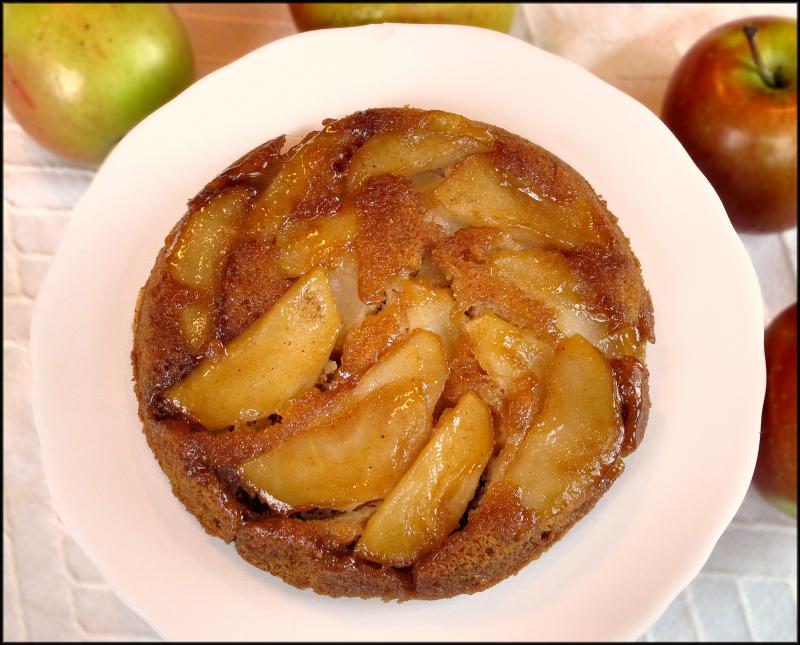Celebrate the start of apple season
With the start of apple season, we selected from over 25 varieties cultivated at Fifer Orchards. We chose Cameo, Fuji and Jonagold to try some new flavors and textures, compared to the standard-issue Granny Smith and Red Delicious stocked at the supermarkets. These were a bit smaller than most grocery store apples, which signaled they were likely younger and tastier.
Despite their less-than-beautiful skins (no added sheen from an industrial wax coating), they were all crisp and juicy. We enjoyed the tangy hints in the Cameos and the sweetness of all three types. Since they’re firm-fleshed varieties, they were ideal for baking in a traditional cake - the upside-down or skillet cake.
For many of us, our first introduction to an upside-down cake was an overly sweetened pineapple and maraschino cherry concoction popularized in the early 1900s. Food historians point to the Hawaiian Pineapple Company (now Dole) and its recipe contest designed to draw attention to the newly introduced canned pineapple rings. But, baking a cake this way didn’t begin with pineapples.
Cooking a cake with a fruit layer on the bottom and inverting it afterward has been popular since the Middle Ages. Before modern ovens, cakes were cooked in cast-iron skillets. It was easy to caramelize fruit, cover it with cake batter and set the pan over the fire to bake. To serve, the cake was released from the skillet onto a plate to display the fruit transformed into a sweet topping.
During the early days in this country, families made cornbread, biscuits and cakes over the glowing coals of a fire where the heat level was relatively consistent. The pan was a cast-iron skillet with legs, called a spider, and the cakes were often called spider-cakes. As home ovens became more prevalent, the legless skillet replaced the spider, and the cakes were renamed skillet cakes.
To enhance the appearance and flavor of a simple skillet cake, cooks would simmer berries, cherries or apples in a mixture of sugar and butter before adding the batter to the pan. Seasoned cast-iron skillets proved ideal for caramelizing the sugar, while preventing the butter from burning.
The tradition of apples as the fruit for this type of cake has roots in the French tarte tatin and skillet custards. In Colonial America, an early version (called a tansey, after an English pudding that featured the tansy flower) was made from sliced apple rounds cooked in a skillet and topped with a sweetened egg batter flavored with rosewater and nutmeg.
For the apple upside-down cake in the photo, I used miniature cast-iron skillets instead of one large skillet. In my efforts not to overfill them, I added less batter, leaving the cake layer a bit thinner (yet still delicious). I’ve included a recipe that will give you more cake to accompany the beautifully caramelized apples.
As an introduction to apple tansey, I’ve included the original version that appeared in Eliza Smith’s 1742 cookbook, “The Compleat Housewife.” She calls for pippins, which are a variety of apples that grew abundantly in Colonial Virginia. I’ve also included a modern interpretation of the recipe, substituting vanilla extract for Smith’s rosewater. The texture of this dish will be more like an omelette than a cake, so you can enjoy an apple tansey for breakfast and apple upside-down cake for dessert.
Apple Upside-down Cake
4 tart apples
1 T lemon juice
1 t cinnamon
1/4 C butter
1/2 C light brown sugar
1/2 C butter
1/2 C sugar
2 eggs
2 t vanilla
2 C flour
1 1/2 t baking powder
1/2 t baking soda
1 C milk
Preheat oven to 350 F. Peel and core the apples; cut into uniform wedges. Place apple pieces in a mixing bowl and drizzle with lemon juice. Sprinkle with cinnamon and toss to combine.
Melt 1/4 C butter in a 10-inch cast-iron skillet over medium. Sprinkle brown sugar evenly over the bottom of the skillet. Arrange apple slices in a decorative pattern and pour in accumulated juices from the bowl. Remove skillet from heat. Cream together 1/2 C butter and 1/2 C sugar until light and fluffy. Add eggs and beat well to combine.
Stir in vanilla. Sift together dry ingredients. Add flour and milk in three alternate portions, mixing well after each addition.
Drop the batter by large spoonfuls over the apples, spreading into a smooth surface. Bake until a cake tester comes out clean, about 40 minutes. To serve, place a serving plate over the skillet and invert to release the cake, fruit side up. Yield: 8 servings.
Original Apple Tansey
Take three pippins (apples), slice them round in thin slices, and fry them with butter; then beat four eggs, with six spoonfuls of cream, a little rosewater, nutmeg, and sugar; stir them together, and pour it over the apples; let it fry a little, and turn it with a pye-plate.
Garnish with lemon and sugar strew’d over it.
Modern Apple Tansey
3 tart apples
2 T butter
4 eggs
2 T heavy cream
1/4 C flour
1/3 C sugar
1/4 t nutmeg
1 t vanilla
1 halved lemon
Core the apples and slice them into thin rounds. Melt butter over medium heat in a skillet.
Evenly arrange the apple slices in the skillet. Cook until their edges begin to brown, turning once. Beat the eggs in a mixing bowl; whisk in cream, flour, sugar, nutmeg and vanilla. Pour the egg mixture over the apples and cook for about 15 minutes. Flip the tansey and cook until batter is completely set, about another 5 minutes.
Transfer to a serving plate. Squeeze lemon juice over the tansey and serve warm.
























































